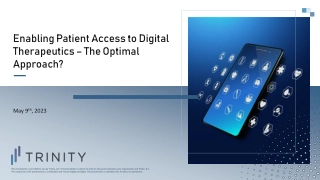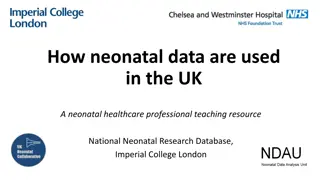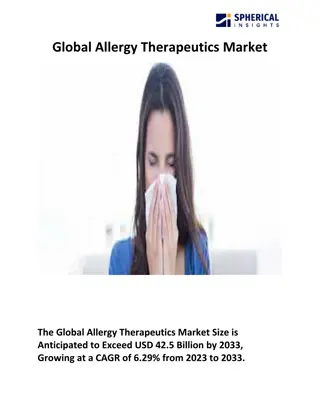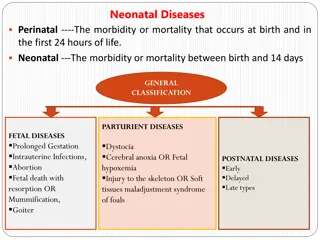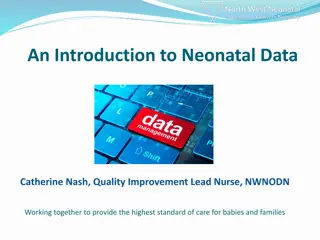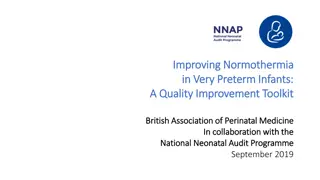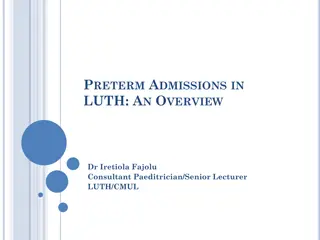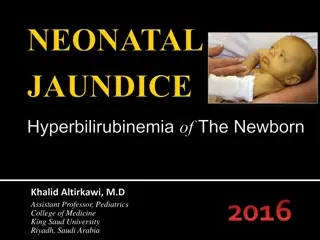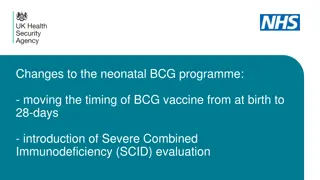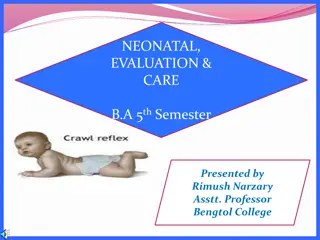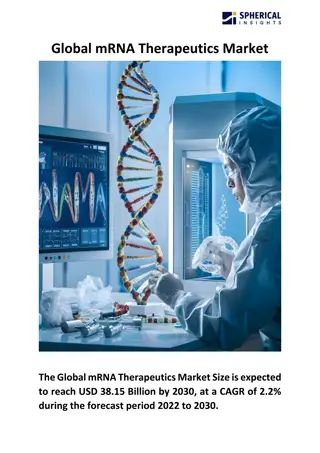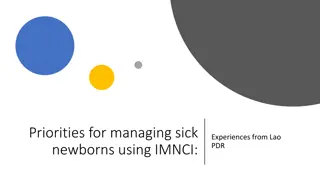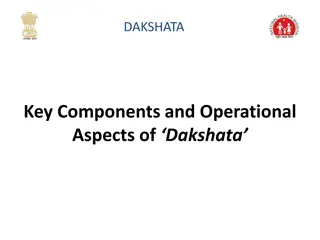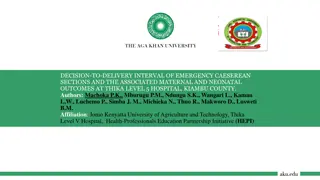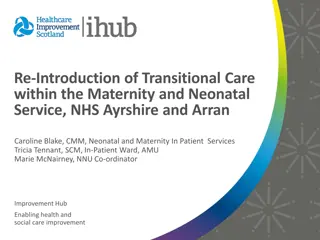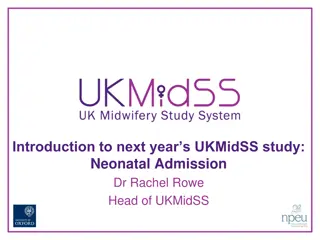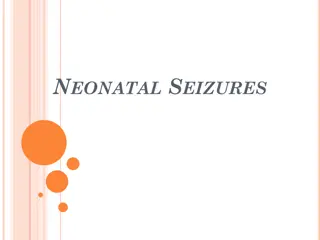Challenges in Supporting Neonatal Therapeutics: A Proposal Overview
Proposal presentation at HESI Annual Meeting discusses challenges in neonatal therapeutics, including off-label drug use in NICU, low clinical relevance in studies, and barriers to conducting neonatal trials. Mandates require inclusion of neonates in pediatric studies, but priorities and study designs are not aligned. Concerns about ethical, emotional, and knowledge gaps contribute to neonates being considered therapeutic orphans.
Uploaded on Oct 05, 2024 | 0 Views
Download Presentation

Please find below an Image/Link to download the presentation.
The content on the website is provided AS IS for your information and personal use only. It may not be sold, licensed, or shared on other websites without obtaining consent from the author. Download presentation by click this link. If you encounter any issues during the download, it is possible that the publisher has removed the file from their server.
E N D
Presentation Transcript
Nonclinical Efficacy & Safety Studies to Support Neonatal Therapeutics: A Proposal HESI Annual Meeting June 10, 2015 Karen Davis-Bruno Ph.D (FDA/CDER/OND) Melissa Tassinari Ph.D(FDA/CDER/OND/DPMH) Jacqueline Carleer Ph.D (EMA PDCO/Chair NcWG) Susan McCune MD (FDA/CDER/OTS) ILSI Health and Environmental Sciences Institute
Disclaimer: This presentation reflects the views of the speaker. It does not necessarily reflect FDA policy This presentation originally given to HESI DART Committee April 22, 2015 ILSI Health and Environmental Sciences Institute 2
The Problem 90% NICU drugs used off label ADE 3X more likely NICU patients have the highest medical errors and ADE rates Efficacy EU prematurity rates are 5-10% USA prematurity rates (12%) worst of any developed country (131st in the world) N Engl J Med 367:1279-81 (2012): Pediatrics 111(4):722-9 (2003): JAMA 285:2114-20 (2001) ILSI Health and Environmental Sciences Institute 3
CDER Neonatal Mandates Under FDASIA 2012 Specifically requires inclusion of neonates as a study population or justification for rationale not requesting a study in neonates in Pediatric Study Plans Pediatric Review Committee requires neonatology members Goal to increase the number of trials conducted in neonates-FDA report to Congress 2016 & every 5 years ILSI Health and Environmental Sciences Institute 4
Neonates- How are we doing? Studies must be clinically relevant 406 medicines studied in pediatrics only 28 (7%) were studied in neonates These 28 drugs are rarely used in NICU Priorities of clinicians, community, academicians, researchers, regulators, industry are not well aligned ILSI Health and Environmental Sciences Institute 5
Neonates Remain Therapeutic Orphans, Why? Neonatal studies are regarded as not needed Disease does not occur in newborns But it does in 1 year olds Neonatal studies are too difficult? Ethical, emotional concerns Knowledge gaps in nonclinical models of neonatal diseases Endpoints do not apply or cannot be measured in newborns PK difficult to measure in newborns, need new formulations Study designs for pediatrics do not fit newborns e.g., smaller # patient population Should limit studies in newborns based on AE in adults, assuming they occur in neonates e.g., QTc? ILSI Health and Environmental Sciences Institute 6
ILSI Health and Environmental Sciences Institute 7 From: S.McCune 1st Neonatal Sci Workshop Oct 2014
Oct 2014 Agenda Innovative trial designs Trials that allow for extrapolation Criteria for initiating trials in neonates PBPK & PKPD modeling Clinical outcome measures Biomarkers Structure of a neonatal consortium & voting on potential projects Our proposal plans to explore nonclinical contributions to neonatal drug development ILSI Health and Environmental Sciences Institute 8
Neonatal Differences & Clinical Trials ILSI Health and Environmental Sciences Institute 9 From: S.McCune 1st Neonatal Sci Workshop Oct 2014
Common NICU Conditions Neonatal Brain Injury: Prevention and treatment of seizures, asphyxia, stroke, intraventricular hemorrhage (IVH) and white matter injury (WMI), leading factors in the development of neurodevelopmental impairment (NDI) Neonatal Lung Injury: Prevention and treatment of Bronchopulmonary Dysplasia (BPD) and Persistent Pulmonary Hypertension of the Newborn (PPHN) Neonatal Gastrointestinal Injury: Prevention and treatment of Necrotizing Enterocolitis (NEC) Perinatal Infection: Prevention and treatment of bacterial and viral infections Retinopathy of Prematurity (ROP): Prevention and treatment Neonatal Abstinence Syndrome (NAS): Treatment of the withdrawal that results from in utero exposure to opiates Prevention of preterm labor and delivery ILSI Health and Environmental Sciences Institute 10 10
Neonates: Unique Pediatric Population Neonates & premies are a special pediatric subpopulation Unique disease conditions Significant physiological differences in organ system development & responses: Glucose, thermoregulation Neurologic, cardiopulmonary, immunologic Can t extrapolate from adult/pediatric disease ILSI Health and Environmental Sciences Institute 11
Neonates require a global systems approach Global Problem Highest proportion of off-label use in neonates Lack of age adapted formulations Delayed/lack of access to innovative meds Knowledge gaps in developmental pharmacology Limited clinical trials Lack of suitable methodology & trial infrastructure for neonates Limited funding for research on special peds population meds development Failure of market driven forces Global Strategies Multi-company/drug trials Prioritization strategies for clinical trials to favor development Innovative methodologies approach Advocate participation & funding Systems approach ILSI Health and Environmental Sciences Institute 12
Pediatric Planning in the Drug Development Process - Timing Approved PIP required for MAA submission PIP process begins Post PIP Marketing Requirements modifications PMR Phase 3 Phase 2 Phase 1 Submission & Review Marketing Approval Agreed PREA requirements PSP Pediatric study plans Within 60 days of meeting modifications ILSI Health and Environmental Sciences Institute issued (BPCA) Written Request 13 PIP: Pediatric Investigation Plan MAA: Marketing Authorization Application
How can nonclinical studies bridge the data gaps? Identify relevant animal models for developmental stage or disease condition of premie/neonate What models are available? What aspect of the condition do they model effectively? What is the limitation of the model? Provide knowledge of the pharmaco-dynamics during development Assess long term effects of acute & chronic treatment on development & outcome ILSI Health and Environmental Sciences Institute 14
Non-clinical Studies for Safety Assessment Safety pharmacology & pharmacodynamics (POC) Pharmacokinetics/Toxicokinetics ADME: (absorption, distribution, metabolism, elimination) General toxicology Genotoxicity Carcinogenicity Reproductive toxicology Local tolerance Special studies Juvenile animal studies (case-by-case basis) Animal models of human disease? ILSI Health and Environmental Sciences Institute 15
JAS as a Tool Juvenile Animal Studies are conducted when existing data from animals and humans are insufficient to support the proposed clinical trials in children Direct Dosing Juvenile animal studies Repro Seg III Repeat dose studies birth weaning Indirect exposure ILSI Health and Environmental Sciences Institute 16
The General Design of Juvenile Study Relevant studies conducted in young animals of an age range developmentally comparable to that during which exposure would occur in humans Design emphasizes assessment of effects on growth and development, with other standard toxicologic endpoints included as appropriate for risk characterization Choice of endpoints informed but not defined by adult animal data Purpose is to identify age-related toxicity (i.e., unique developmental effects as well as differences in sensitivity) Standard histopathology to be conducted at end of treatment; more specific or expanded assessments of certain organs (e.g., brain) may be warranted Neurobehavioral and reproduction functions are usually assessed and any other relevant systems as deemed necessary ILSI Health and Environmental Sciences Institute 17
Animal Model Application to Human Premature/Neonate Rodent, rabbits, guinea pig, dog, pigs, NHPs Consider litter effects of multiparous species with data interpretation Consider species/strain differences Determine if model is similar to human for the specific system being modeled e.g.: Respiratory development similar across species Maturation of brain regions may differ across species Consider relevance of animal model of human disease/condition What questions are we asking the animal model to address? ILSI Health and Environmental Sciences Institute 18
Multiple component approach Global development Neonates Parents Healthcare professionals Health insurance agencies Researchers Industry Policy makers ILSI Health and Environmental Sciences Institute 19
Proposal for a Multidisciplinary Working Group Using a multi-discipline group e.g.: neonatologists, teratologists, researchers, regulators Identify different initiatives to avoid duplication Identify major gaps in pre-term & term neonates drug development (disease vs model) Identify neonatal animal models of human disease Address how to best leverage neonatal nonclinical models to support safety and POC for human neonatal disease Extrapolate lessons learned pediatric only or 1st in pediatric development programs Develop relevant study designs & data that can be obtained from nonclinical models ILSI Health and Environmental Sciences Institute 20
Mutual Aims Neonate Proposal Publish review of expert group s analysis Explore relevance & modifications of neonatal nonclinical models of human neonatal disease Workshop Bring together industry, academia,neonatologists, & regulators to move the agenda forward on behalf neonates/premies ILSI-HESI DART Develop consensus on appropriate use of toxicity data for human Initiate activities to advance DART Provide a forum for scientists can exchange information ILSI Health and Environmental Sciences Institute 21
Acknowledgement Karen Davis-Bruno PhD (FDA/CDER/OND) Melissa Tassinari PhD (FDA/CDER/OND/DPMH) Jacqueline Carleer PhD (EMA PDCO/Chair NcWG) Susan McCune MD (FDA/CDER/OTS) Thank you ILSI Health and Environmental Sciences Institute 22
















